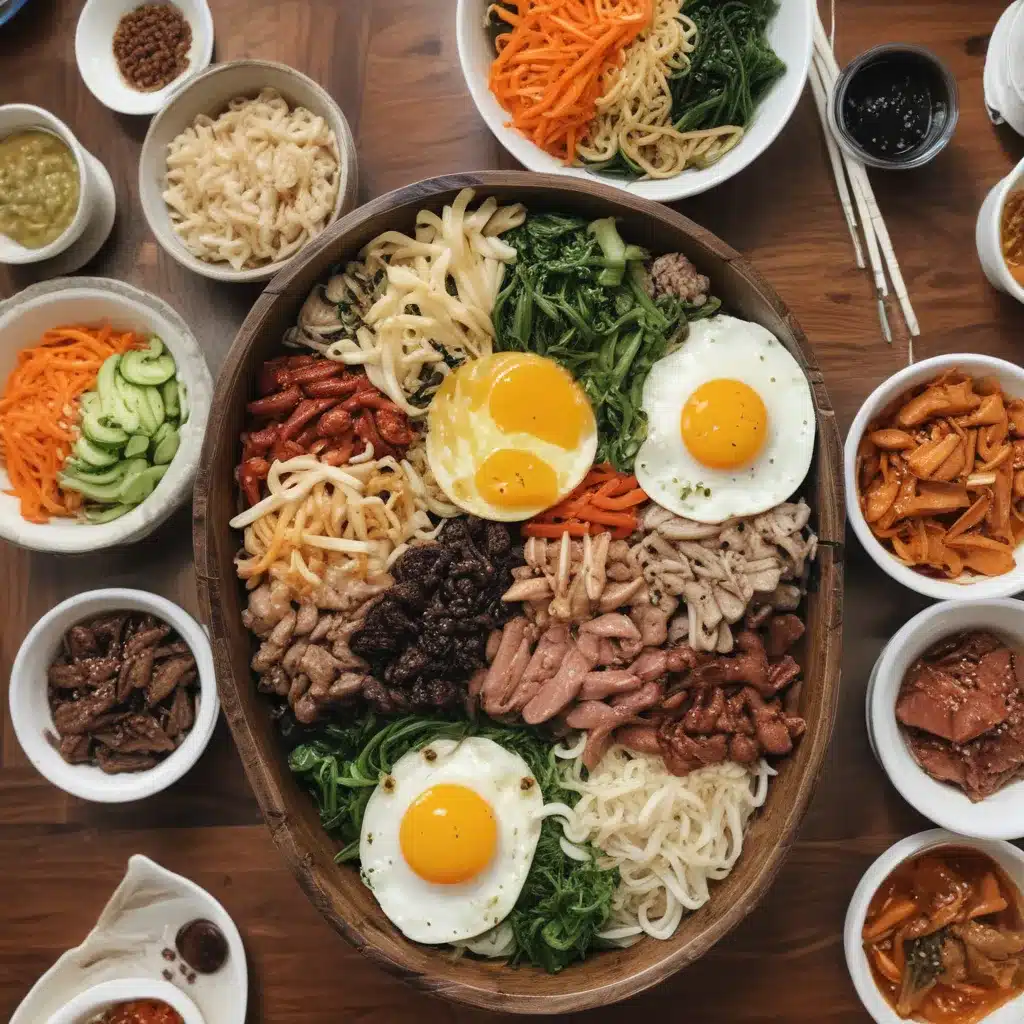
The Culinary Journey Begins
As I step through the doors of Korean Garden, the tantalizing aroma of sizzling vegetables and the unmistakable scent of toasted sesame oil immediately transport me to the bustling streets of Seoul. This unassuming Korean restaurant, nestled in the heart of Boston, has become my go-to destination for an authentic taste of bibimbap – a beloved Korean rice dish that has captivated the hearts and palates of food enthusiasts worldwide.
But what is it about bibimbap that has me so captivated? Is it the harmonious blend of flavors, the vibrant colors, or the satisfying texture that has me returning time and time again? Join me as I delve into the rich history and culinary artistry behind this iconic Korean dish, and discover why it has become a must-try for anyone exploring the dynamic culinary landscape of Boston.
The Art of Assembling Bibimbap
The first thing that strikes me as I step up to the counter is the sheer visual appeal of the bibimbap preparation. The chef, with the precision of a master artist, carefully arranges a rainbow of ingredients atop a bed of steaming hot rice. From the crisp, freshly sautéed vegetables to the perfectly cooked, marinated beef, each component is meticulously placed to create a visually stunning and harmonious dish.
But bibimbap is more than just a feast for the eyes; it’s a culinary experience that engages all the senses. As I take my first bite, the flavors and textures explode in my mouth – the savory umami of the beef, the crunch of the vegetables, the richness of the runny egg yolk, and the soothing, starchy comfort of the rice, all coming together in a symphony of taste and texture.
The true art of bibimbap, however, lies in the way the diner assembles and mixes the components. With a quick stir of the chopsticks, I watch as the vibrant hues blend together, creating a visually captivating and flavorful medley. It’s a dance of flavors, a celebration of the individual ingredients that, when combined, transcend their individual parts to form something truly extraordinary.
Honoring Tradition, Embracing Innovation
As I delve deeper into the world of bibimbap, I can’t help but marvel at the rich cultural heritage that this dish represents. Bibimbap has its roots in the traditional Korean royal court cuisine, where it was served as a symbolic representation of harmony and balance. The varied colors and textures of the ingredients were not merely a feast for the senses, but also a reflection of the country’s diverse regional cuisines and the yin-yang philosophy that permeates Korean culture.
Yet, even as bibimbap remains firmly rooted in tradition, the dish has also evolved and adapted to meet the changing tastes and preferences of modern diners. At Korean Garden, I’ve discovered innovative takes on the classic bibimbap, with chefs experimenting with new ingredient combinations and flavor profiles to create truly unique and memorable dishes.
One such creation that has caught my eye is the “Kimchi Bibimbap,” which features the fiery, fermented cabbage as the star of the show. The sharp, tangy notes of the kimchi provide a delightful counterpoint to the rich, creamy egg yolk and the earthy, nutty flavors of the toasted sesame oil. It’s a bold and unapologetic interpretation of a beloved classic, and it’s the perfect example of how Korean cuisine continues to evolve and captivate the palates of food enthusiasts around the world.
A Sensory Celebration
As I sit at one of the cozy tables in Korean Garden, surrounded by the warmth of the intimate space and the lively chatter of other diners, I can’t help but feel a sense of connection to the rich cultural heritage that bibimbap represents. This dish is more than just a delicious meal; it’s a sensory celebration, a culinary journey that transports me to the vibrant streets of Seoul and immerses me in the rich tapestry of Korean cuisine.
With each spoonful, I find myself transported to a different time and place, from the bustling markets of Gwangjang to the serene gardens of the Gyeongbokgung Palace. The flavors, the textures, the colors – they all come together to create a truly unforgettable dining experience that transcends the boundaries of mere sustenance and becomes a profound exploration of culture, heritage, and the power of food to connect us to the world around us.
Discover the Essence of Korean Cuisine
As I savor the final bites of my bibimbap, I can’t help but feel a deep sense of gratitude for the talented chefs and dedicated servers who have brought this culinary masterpiece to life. Their unwavering commitment to authenticity and their passion for sharing the rich tapestry of Korean cuisine with the world have made Korean Garden a true gem in the heart of Boston.
Whether you’re a seasoned connoisseur of Korean food or a curious newcomer to this vibrant culinary landscape, I can’t recommend bibimbap enough. It’s a dish that not only delights the palate but also celebrates the rich cultural heritage and innovative spirit of Korean cuisine. So why not embark on your own culinary journey and discover the essence of this beloved dish at Korean Garden? I promise, it’s an experience you won’t soon forget.
